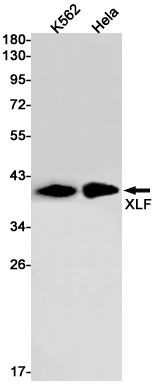
| WB | 1/500-1/1000 | Human,Mouse,Rat |
| IF | 咨询技术 | Human,Mouse,Rat |
| IHC | 咨询技术 | Human,Mouse,Rat |
| ICC | 技术咨询 | Human,Mouse,Rat |
| FCM | 咨询技术 | Human,Mouse,Rat |
| Elisa | 咨询技术 | Human,Mouse,Rat |
| Aliases | Cernunno; Nhej1; Non homologous end joining factor 1; Protein cernunnos; XLF; XRCC4 like factor |
| Entrez GeneID | 79840 |
| WB Predicted band size | Calculated MW: 33 kDa; Observed MW: 39 kDa |
| Host/Isotype | Rabbit IgG |
| Antibody Type | Primary antibody |
| Storage | Store at 4°C short term. Aliquot and store at -20°C long term. Avoid freeze/thaw cycles. |
| Species Reactivity | Human,Mouse,Rat |
| Immunogen | Recombinant protein of human XLF |
| Formulation | Purified antibody in TBS with 0.05% sodium azide,0.05%BSA and 50% glycerol. |
+ +
以下是关于XLF抗体的3篇参考文献,涵盖其开发与应用:
---
1. **"Cernunnos, a novel nonhomologous end-joining factor, is mutated in human immunodeficiency with microcephaly"**
- **作者**: Buck, D., et al.
- **摘要**: 该研究首次报道了XLF(Cernunnos)蛋白在DNA修复中的作用,并开发了针对XLF的多克隆抗体。通过免疫印迹和免疫荧光实验,验证了抗体在检测患者细胞中XLF蛋白缺失的可靠性,为诊断XLF缺陷相关免疫疾病提供了工具。
---
2. **"XLF interacts with the XRCC4-DNA ligase IV complex to promote DNA nonhomologous end-joining"**
- **作者**: Ahnesorg, P., et al.
- **摘要**: 本文阐明了XLF与XRCC4-DNA连接酶IV复合物的相互作用机制。研究中利用抗XLF抗体进行免疫共沉淀(Co-IP)和蛋白质互作分析,证实了XLF在非同源末端连接(NHEJ)中的关键功能,为抗体在分子互作研究中的应用提供了范例。
---
3. **"Increased efficiency of immunoglobulin class switch recombination in XLF-deficient mice"**
- **作者**: Stavnezer, J., & Schrader, C.E.
- **摘要**: 通过构建XLF缺陷小鼠模型,研究使用抗XLF抗体检测B细胞中蛋白表达水平,发现XLF缺失反而增强抗体类别转换重组(CSR)效率。该抗体在揭示XLF对免疫多样性的调控作用中起到关键实验支持。
---
这些文献均涉及XLF抗体的开发或应用,涵盖基础机制研究、诊断工具开发及功能验证等领域。如需具体期刊信息或页码,可进一步补充检索关键词(如“XLF antibody methodology”)。
**Background of XLF Antibody**
The XLF (XRCC4-like factor) antibody is a crucial tool in studying the XLF protein, also known as Cernunnos, which plays a pivotal role in DNA repair processes. XLF is a core component of the non-homologous end-joining (NHEJ) pathway, a primary mechanism for repairing DNA double-strand breaks (DSBs) in mammalian cells. Discovered in 2003. XLF interacts directly with XRCC4. stabilizing the ligase IV complex to facilitate efficient DNA end ligation during NHEJ. This interaction is essential for maintaining genomic stability, particularly during V(D)J recombination in developing lymphocytes, a process critical for adaptive immunity.
XLF deficiency in humans is linked to severe immunodeficiency, microcephaly, and heightened radiosensitivity, underscoring its biological importance. Researchers utilize XLF antibodies in techniques like Western blotting, immunofluorescence, and immunoprecipitation to investigate its expression, localization, and interactions within the DNA repair machinery. Structural studies reveal XLF’s rod-shaped architecture, featuring an N-terminal domain for binding XRCC4 and a C-terminal extension mediating filament formation.
Moreover, XLF antibodies aid in exploring its phosphorylation dynamics (e.g., by ATM kinase post-DNA damage) and its role in cancer biology, as dysregulated NHEJ contributes to oncogenic translocations. These antibodies are vital for advancing therapeutic strategies targeting DNA repair deficiencies or enhancing radiotherapy efficacy.
×